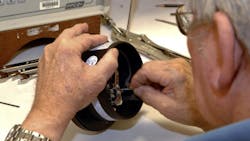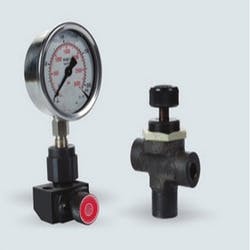The Old Timer of Royal Oak, Mich., was a regular contributor to H&P years before we ever even heard of the internet. But most of his advice is just as ueful — and interesting — today.
So rather than leave his wisdom printed on pages archived in our storage room, I pulled out issues from the late 1980s and early 1990s and will reproduce relevant entries in this blog. Here is my second entry, which was originally published in the April 1987 issue:
Special hook-up saves pressure gauges
We started with master gauges fitted to small, high-pressure quick-acting couplings. We’d snap them on momentarily, make quick adjustments on the pressure controls, then disconnect the gauges and store them in the foreman’s cabinet. This worked well, until the foreman decided they had to check pressure hourly and wanted permanently installed gauges.
Special liquid-filled gauges that were supposed to last the life of the machine lasted a week or so. High-G aircraft gauges survived for two weeks. We were wasting a lot of time and money on replacements, and no one was happy.
Then I remembered a jerry-rigged gauge that we used on some old hammering die casting machines years ago. We ordered a large dial gauge (for remote readability) and mounted it with rubber grommets to a building beam. Then we formed a coiled connection by winding a length of 1/16-in ID lubrication tubing around a gallon paint can. One end of the coil was attached to the gauge; the other was fitted with a quick-acting coupling for the machine’s gauge port.
Whenever the foreman wanted to check pressure, he connected the coupling. From the pressure control station he could read the remote gauge and watch the dial respond slowly to any changes. The 20 ft of tubing absorbed all the hydraulic shock before it reached the gauge, and the building itself damped the mechanical shock and vibration.
This set-up lasted several years. The line foremen were elated, and maintenance was happy that the large (and inexpensive) gauges lasted 50 times longer than anything else we had tried.
In retrospect, I would've asked the Old Timer if he had tried using a gauge isolator — a valve mounted between the gauge and port that prevents pressurized fluid from reaching the gauge unless a button (which opens a valve) is pushed. This dramatically increases the life of gauges by preventing pressure cycling, pulsations, and spikes from being reaching the gauge mechanism until the button is pushed.
But it sounds as if the quick-coupling setup they tried essentially did the same thing.
About the Author
Alan Hitchcox Blog
Editor in Chief
Alan joined Hydraulics & Pneumatics in 1987 with experience as a technical magazine editor and in industrial sales. He graduated with a BS in engineering technology from Franklin University and has also worked as a mechanic and service coordinator. He has taken technical courses in fluid power and electronic and digital control at the Milwaukee School of Engineering and the University of Wisconsin and has served on numerous industry committees.

Leaders relevant to this article:


